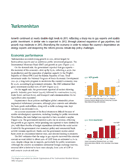ADB: Turkmenistan Outlook for 2012
Growth continued at nearly double-digit levels in 2011, reflecting a sharp rise in gas exports and sizable public investment. A similar rate is expected in 2012, through planned expansion of gas pipelines, but growth may moderate in 2013. Diversifying the economy in order to reduce the country’s dependence on energy exports and deepening the reform process remain key policy challenges.
Turkmenistan recorded strong growth in 2011, driven largely by hydrocarbon exports and an ambitious public investment program. The International Monetary Fund (IMF) put growth at 9.9%. On the demand side, the government reported that gas exports shot up by 75.2%, reflecting a 42.5% rise in production and the expansion of pipeline capacity to China (PRC) and Iran. The IMF estimated that gross investment reached 60% of GDP.
Industry grew fastest (24.2%), followed by construction (12.5%), trade (8.9%), services (8.1%), and transport and communications (8.0%). Agriculture also expanded.
Although the country accumulates substantial foreign exchange reserves, external debt is believed to have risen sharply, from 2.6% of GDP at end-2009 to 20.5% at end-2011.
Hydrocarbon exports will remain the chief source of growth and development project financing. GDP growth of 10.0% is forecast in 2012, reflecting further expansion of pipeline capacity to China and large public investment. Somewhat slower growth (about 9%) is anticipated in 2013.
The government intends to widen its export destinations and a private firm’s audit of gas deposits, released in October 2011, confirmed reserves of up to 26.2 trillion m³, among the world’s largest.
Over time Turkmenistan will benefit from enhanced cooperation and trade with neighbouring countries. The North-South railway line, scheduled for completion by 2014, will improve its access to Kazakhstan, the Persian Gulf, the Russian Federation, and South Asia. This line could become the region’s main route for transporting goods such as petroleum, minerals, agricultural products, and textiles.

